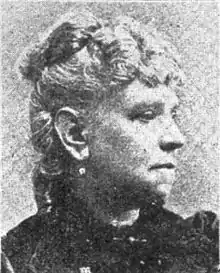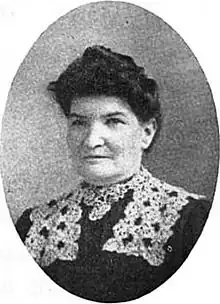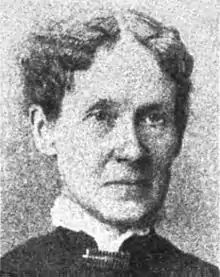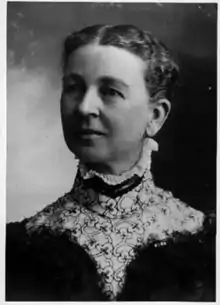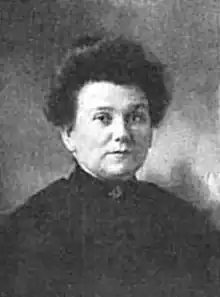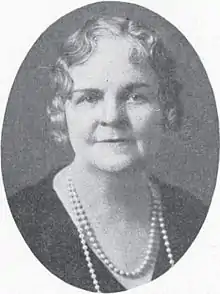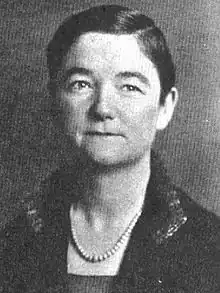 The official seal of the Primary adopted in 1940 | |
| Formation | August 25, 1878 |
|---|---|
| Type | Non-profit |
| Purpose | Religious instruction; personal standards and development; child/family support |
| Headquarters | Salt Lake City, Utah, United States |
Membership | 1.1 million children aged 3–11[1] |
General President | Camille N. Johnson |
Main organ | General presidency and general board |
Parent organization | The Church of Jesus Christ of Latter-day Saints |
| Affiliations | Members join the Young Men or Young Women at age 12 |
| Website | Primary |
The Primary (formerly the Primary Association) is the children's organization of the Church of Jesus Christ of Latter-day Saints (LDS Church). It acts as a Sunday school organization for the church's children (ages 3–11).[2]
Purpose, objectives, and theme
The official purpose of Primary is to help parents in teaching their children to learn and live the gospel of Jesus Christ.[3] The official objectives of Primary are to:
- Teach children that they are children of God and that Heavenly Father and Jesus Christ love them;
- help children learn to love Heavenly Father and Jesus Christ;
- help children prepare to be baptized, to receive the Holy Ghost, and to keep their baptismal covenants;
- help children grow in their understanding of the gospel plan and provide opportunities for them to live gospel principles;
- help boys prepare to receive the priesthood and be worthy to use this power to bless and serve others; and
- help girls prepare to be righteous young women, understand the blessings of the priesthood and the temple, and serve others.[3]
The Primary theme is "All thy children shall be taught of the Lord; and great shall be the peace of thy children" (Isaiah 54:13).[3][4]
Format
While Primary classes will differ slightly in different regions, most meetings are standardized. For the second half of primary, children are separated into age groups with names for each group (see below).
Where participants, classrooms or teachers are limited, multiple age-grouped classes may be taught together. In most congregations, Primary classes are co-ed.[5]
Primary begins with a prayer, scripture (or Article of Faith), and a short talk, all of these given by primary children. About 20 minutes are then spent on music, primarily from the Children's Songbook. After music time, children are then sent to their individual classes where they are taught lessons from Come, Follow Me - For Primary.
Class names
The names of the classes in Primary have varied over time. The following is a partial list of names that have been applied to different age groups in Primary. In January 2010, the names of the classes were changed to the age of children entering the class, i.e., 4-year-olds are in the class CTR 4. Previously, names were indicative of the age children would turn the coming year, (4-year-olds in CTR 5).[5]
| Age (on January 1) | Present Class Name | Past Class Names Used |
|---|---|---|
| 18 mos. | Nursery | Rainbows |
| 3 | Sunbeams | Moonbeams |
| 4 | CTR 4 | Sunbeams Stars CTR 5 |
| 5 | CTR 5 | Stars CTR 6 |
| 6 | CTR 6 | Rainbows CTR 7 |
| 7 | CTR 7 | Zion’s Boys Zion’s Girls CTR Pilots Co-Pilots Top Pilots Targeteers CTRs CTR 8 |
| 8 | Valiant 8 | Zion’s Boys Zion’s Girls CTR Pilots Co-Pilots Beacons Top Pilots Targeteers CTRs Valiant 9 |
| 9 | Valiant 9 | Girls:
Larks |
| 10 | Valiant 10 | Girls:
Bluebirds |
| 11 | Valiant 11 | Girls:
Bluebirds |
| 12+ | See Young Women | Seagulls Home Builders Lihomas Mi-kan-wees |
Nursery
.jpg.webp)
A separate class, known as nursery, is held for children ages 18 months to 3. It is led under the direction of the Primary presidency by at least two people, a nursery leader and assistant nursery leader(s). Nursery leaders are required to be the same gender unless they are married.
Nursery classes have a lesson, free play time, snack time, and music time primarily using the Children's Songbook. Additionally, two prayers are given by children with help from the adult leaders. While no particular order is required, it is recommended that the order be the same every week.
Teachers use the "Behold Your Little Ones: Nursery Manual" for lesson plans and other resources.[6]
History
Primary was first organized in 1878 by Aurelia Spencer Rogers in Farmington, Utah, and adopted church-wide in 1880 under the direction of Louie B. Felt, who served as the president of the organization through 1925. Rogers was concerned because younger Latter-day Saint children had too much unsupervised time due to the long hours that fathers and older sons kept on the farms and mothers and older daughters in the home. In particular, Rogers felt that the younger boys in the community were becoming unruly and mischievous. With permission from church leaders and under the initial direction of General Relief Society President Eliza R. Snow, Rogers organized a Primary Association for her local Farmington congregation on August 11, 1878. Two weeks later, the first meeting was held on August 28, with 215 children in attendance. That day, boys were specifically taught not to steal fruit from orchards and girls were taught not to hang on wagons. In addition, they were given lessons on faith, manners, obedience, and other principles.
May Anderson, the second general president of the Primary Association from 1925 to 1939, initiated what became Primary Children's Hospital in Salt Lake City (now part of Intermountain Healthcare). Anderson also helped establish kindergartens in Utah. In the 1970s, as a result of the Priesthood Correlation Program, the Primary Association was renamed "Primary".
Beginning in April 2021, Camille N. Johnson was the Primary General President, with Susan H. Porter as First Counselor and Amy Wright as Second Counselor.[7]
In the church's April 2022 general conference, it was announced that Johnson would become the new Relief Society General President on August 1, 2022. As a result, on that date, Porter became the new Primary General President, with Wright serving as First Counselor and Tracy Y. Browning as Second Counselor.[8][9]
Chronology of the general presidency of the Primary
| No. | Dates | General President | First Counselor | Second Counselor | |||
|---|---|---|---|---|---|---|---|
| 1 | 1880–1925 | Louie B. Felt | 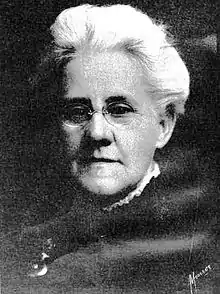 |
Matilda M. Barratt (1880–88) Lillie T. Freeze (1888–1905) May Anderson (1905–25) |
Clara C. M. Cannon (1880–95) Josephine R. West (1896–1905) Clara W. Beebe (1906–25) |
||
| 2 | 1925–39 | May Anderson | 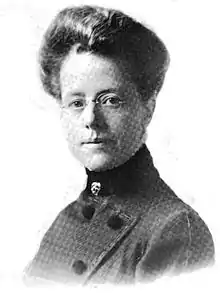 |
Sadie Grant Pack (1925–29) Isabelle S. Ross (1929–39) |
Isabelle S. Ross (1925–29) Edna Harker Thomas (1929–33) Edith E. H. Lambert (1933–39) |
| |
| 3 | 1940–43 | May Green Hinckley | Adele C. Howells | Janet M. Thompson (1940–42) LaVern W. Parmley (1942–43) |
Parmley | ||
| 4 | 1943–51 | Adele C. Howells | LaVern W. Parmley | Dessie G. Boyle | |||
| 5 | 1951–74 | LaVern W. Parmley | Arta M. Hale (1951–62) Leone W. Doxey (1962–69) Lucile C. Reading (1970) Naomi W. Randall (1970–74) |
Florence H. Richards (1951–53) Leone W. Doxey (1953–62) Eileen R. Dunyon (1962–63) Lucile C. Reading (1963–70) Florence R. Lane (1970–74) |
|||
| 6 | 1974–80 | Naomi M. Shumway | Sarah B. Paulsen (1974–77) Colleen B. Lemmon (1977–80) |
Colleen B. Lemmon (1974–77) Dorthea C. Murdock (1977–80) |
|||
| 7 | 1980–88 | Dwan J. Young | Virginia B. Cannon | Michaelene P. Grassli | |||
| 8 | 1988—94 | Michaelene P. Grassli | Betty Jo N. Jepsen | Ruth B. Wright | |||
| 9 | 1994–99 | Patricia P. Pinegar | Anne G. Wirthlin | Susan L. Warner | |||
| 10 | 1999–2005 | Coleen K. Menlove | Sydney S. Reynolds | Gayle M. Clegg | |||
| 11 | 2005–10 | Cheryl C. Lant | Margaret S. Lifferth | Vicki F. Matsumori | |||
| 12 | 2010–16 | Rosemary M. Wixom | Jean A. Stevens (2010–15) Cheryl A. Esplin (2015–16) |
Cheryl A. Esplin (2010–15) Mary R. Durham (2015–16) |
|||
| 13 | 2016–2021 | Joy D. Jones | Jean B. Bingham (2016–17) Bonnie H. Cordon (2017–18) Lisa L. Harkness (2018-21) |
Bonnie H. Cordon (2016–17) Cristina B. Franco (2017-21) |
|||
| 14 | 2021–2022[10] | Camille N. Johnson | Susan H. Porter | Amy A. Wright | |||
| 15 | 2022- | Susan H. Porter[11] | Amy A. Wright | Tracy Y. Browning | |||
|}
Primary in the church today
Presently, the worldwide Primary provides Sunday school and church-related activities to approximately 1.1 million Latter-day Saint children.[1] In most congregations, optional nursery care and supervision is available for children from 18 months to age 3. Classroom instruction begins for three-year-olds and continues to age 12, with classes grouped by age. At the beginning of the year they turn 12, children begin to attend Sunday School and the Young Men or Young Women programs. The Primary has its own songbook, made up of original songs and hymns modified for children.
Child Safety
All members called to serve in a position that deals with youth or children are required to take the Church's "Protecting Children and Youth" training module which is available on the Church's website for free.[12]
Nursery and Primary leaders are required to release children only to members of their immediate families unless permission has been granted for someone else to pick the child up.[6]
See also
Notes
- 1 2 Tad Walsh, "Preparing to split up, LDS General Primary Presidency looks back on 5 years of service together", Deseret News, March 27, 2015.
- ↑ Although children had, by long-standing practice, participated in Primary until their 12th birthdays, on December 14, 2018, the First Presidency announced that children would advance from Primary as a group in January of the year in which they would turn 12.
- 1 2 3 "Primary", Handbook 2: Administering the Church (Salt Lake City, Utah: LDS Church, 2010) § 11.1.
- ↑ 3 Nephi 22:13; see also Isaiah 54:13.
- 1 2 "12. Primary". www.churchofjesuschrist.org. Retrieved December 12, 2023.
- 1 2 "Introduction". www.churchofjesuschrist.org. Retrieved December 12, 2023.
- ↑ "The Primary Presidency Oversees Teaching of Children Worldwide". newsroom.churchofjesuschrist.org. April 3, 2021. Retrieved June 24, 2021.
- ↑ "Meet the New Leaders Called at the April 2022 General Conference". newsroom.churchofjesuschrist.org. April 2, 2022. Retrieved May 15, 2022.
- ↑ Sustaining of General Authorities, Area Seventies, and General Officers, Liahona, May 2022, pp.30-31.
- ↑ Johnson's term of service ended on August 1, 2022
- ↑ Porter's term of service began on August 1, 2022
- ↑ "Protecting Children and Youth". www.churchofjesuschrist.org. Retrieved December 12, 2023.
